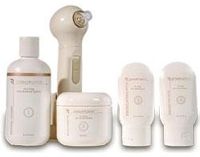Once upon a time, not very long ago, microdermabrasion was a lavish treatment only available for a steep price at high-end dermatology practices. Now that affordable microdermabrasion products – kits, creams and scrubs – are lining shelves, it's tempting to forgo the dermatologist's office. But are they safe to use at home?
What Is Mircodermabrasion?
Advertisement
Microdermabrasion is a nonsurgical way to remove the outermost layer of skin, leaving the fresh layer underneath visible, and potentially hiding scars, sun damage and discoloration. With in-office microdermabrasion, a handheld device blasts the face with exfoliating crystals and then vacuums away dead skin cells. Some dermatologists use a diamond-tipped wand to perform the procedure [source: American Society of Plastic Surgeons]. Its bigger sibling is dermabrasion, in which a dermatologist or plastic surgeon "refinishes" your skin by applying a local anesthetic before scraping away the outermost layer of skin to minimize scars and wrinkles [source: American Society of Plastic Surgeons].
Can You Do It at Home?
At-home microdermabrasion products typically consist of an abrasive cream or scrub, sometimes paired with a battery-powered or rechargeable applicator. These kits usually retail for $50 or less (although you can spend much, much more). But are they worth the money? They won't pack the resurfacing punch of a professional treatment, and results won't be as dramatic even after multiple applications, but for people with delicate skin, the gentler touch of at-home kits may be a good thing, as professional microdermabrasion can cause inflammation [source: Evanas].
Even if you don't suffer from sensitive skin, high-quality at-home microdermabrasion products can be beneficial, says dermatologist Doris Day. "You just don't want to overstrip the skin, so it's not something you do on a daily basis," she cautions. Day recommends choosing a well-recognized brand, such as Olay Pro-X, or using a skin cleansing brush, which has similar effects to microdermabrasion. She notes that at-home microdermabrasion products can be used on the hands, neck and chest as well as the face.
For those willing to make a real investment, microdermabrasion machines described as "professional-grade" are available to consumers for hundreds or even thousands of dollars. You'll want to conduct plenty of research or even speak to your dermatologist before pulling the trigger, however. Experts also warn against the temptation to overuse home microdermabrasion machines, causing broken capillaries or irritation [source: Lambert].
For more information on microdermabrasion and other skin treatments, check out the links on the next page.
Advertisement


